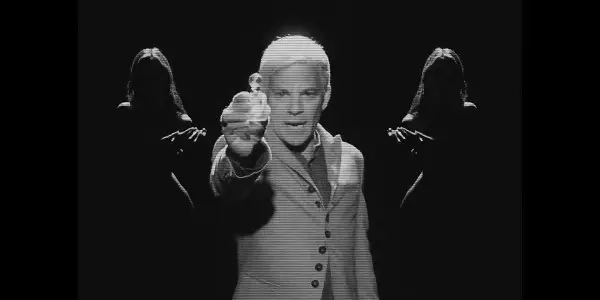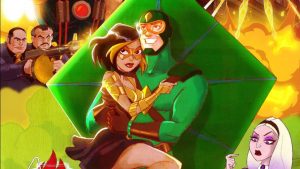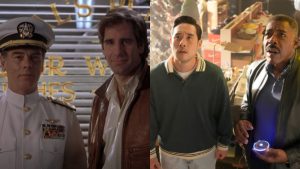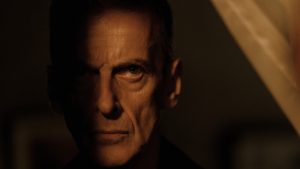
Divinity, written and directed by Eddie Alcazar, is a compelling sci-fi body horror, even though it never fully comes together as something groundbreaking, but there’s a hypnotic quality to the journey it takes you on. One that blends mystery, sci-fi, and horror into a visually exciting package that keeps you engaged, wondering where the film will take you next as you hurtle further into its unique cinematic world.
1950s/1960s Sci-Fi Inspiration
Utilizing black and white adds to the films time-warped aesthetic, bringing to life a vision of what people in the 1950s and 60s imagined of the future. But this is combined with more modern images and sensibilities as well, creating a unique experience that feels like it exists disconnected from how we view time.
Divinity’s strengths come from its idea to take a story that could be an episode of The Twilight Zone and twist it into something more intense and more in tune with midnight cult movies.
So much of Divinity is in tune with this earlier era of science fiction from its retro-futuristic sets, especially the lab of scientist Sterling Pierce (Scott Bakula) and the expansive desert houses of his two children Jaxxon (Stephen Dorff) and Rip (Michael O’Hearn).
source: Utopia, Sumerian
Divinity film comes together in its climax, creating a battle with stop-motion elements that adds a much-needed energy to the film, but this is one of the film’s standout moments and it comes too late.
The mystery at the center of Divinity feels like it could have been in The Twilight Zone with its shocking revelation, twisting what Jaxxon and his brother view as a utopia into something terrible. Divinity does a great job making the film also evoke this with its costume and set design as well as its directing. The way Alcazar directs Divinity feels in tune with films of that era, adding suspense through careful framing, especially during the film’s climax.
Style Over Substance
Divinity is a unique experience, blending styles in a way that is captivating to behold, but the science fiction story underneath it all never fully comes together. Plot threads are introduced and never go beyond one or two moments, highlighting the stylistic visual over continuing these aspects of the overarching story.
One of the issues that makes this visually distinct film never reach its full potential is its simplistic storyline that seems to be pointing toward one metaphor throughout the film, rather than focusing this energy on telling the specific story at hand.
Divinity thinks its story and commentary are more powerful and deeper than they actually are, adding a pretentious energy to the film that makes even the most visually interesting scenes feel not completely warranted.
source: Utopia, Sumerian
There are moments where Divinity works really well, as we see a unique depiction of the future wrapped around the past come together with its use of antiquated commercials with narrations that feel straight out of the 1950s/60s and costume design reminiscent of forgotten sci-fi. But, there comes a point where well-contrasted black and white shots of desert landscapes, bulked bodies, and mysterious labs are not enough to keep us engaged.
There is a scene where we are introduced to an aspect of the story focusing on pure beings sent to correct the universe after the invention of the drug known as Divinity. The film focuses on how Jaxxon has corrupted his father’s vision of what this drug could be, and now the entire world is obsessed with Divinity, treating it like a party drug.
This idea of corrupting the natural world by trying to play God is rooted throughout the film as its major message, but the film introduces these pure beings in a scene or two, and then almost forgets about it.
Watching Divinity is a unique cinematic experience, but is it worth it for an on-the-nose message about the dangers of trying to achieve immortality? The film is interesting to behold and is unlike anything you have seen in theaters recently, but it could have been so much more. The sci-fi and body horror elements are not explored enough.
source: Utopia, Sumerian
This blend of mysterious 50s sci-fi with more intense body horror is well-intentioned, but we are left waiting for images that are more shocking, creating a greater juxtaposition with its melding of sensibilities and eras. Yes, the revelation is somewhat shocking, but its also expected in a story about an immortality cure.
Conclusion
Divinity has its moments, especially when it blends the modern, futuristic, and the retro to create a world reminiscent of how someone in the 1960s would imagine the future. But at times, this focus on creating a unique visual aesthetic takes away from energy that could be spent developing the characters and working on the story.
Divinity expands its theatrical release November 3rd.
Does content like this matter to you?
Become a Member and support film journalism. Unlock access to all of Film Inquiry`s great articles. Join a community of like-minded readers who are passionate about cinema – get access to our private members Network, give back to independent filmmakers, and more.




